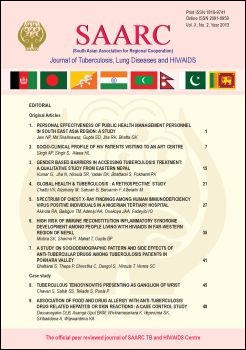A Study On Sociodemographic Pattern And Side Effects Of Anti-Tubercular Drugs Among Tuberculosis Patients In Pokhara Valley
DOI:
https://doi.org/10.3126/saarctb.v10i2.9712Keywords:
Ethnic groups, Mycobacterium tuberculosis, Socioeconomic status, TuberculosisAbstract
Introduction: Tuberculosis is an infectious disease that mainly affects the lungs. Tuberculosis is one of the leading causes of morbidity and mortality in most developing countries. The SAARC region accounts more than 32% of global burden with 0.6 million deaths every year and 2.5 million new cases annually. The main aim of our study was to determine the socio-demographic patterns among tuberculosis patients in Pokhara Valley and side effects of anti tubercular drugs.
Methodology: This study was conducted among 199 tuberculosis patients at Western Regional Tuberculosis Center, Pokhara, Nepal. These patients diagnosed as new as well as retreatment pulmonary tuberculosis cases were interviewed. Study variables such as age, gender, ethnicity, side effect encountered during the treatment, smoking and alcohol habit, socioeconomic status were statistically analyzed.
Results: Among the 199 patient enrolled, 167(84%) patients were found to have one or more side-effects. Signifi cant relation was found between smoking and alcohol intake, socioeconomic status and disease occurrence. Prevalence of tuberculosis was higher among Gurungs. Conclusion: Socio-demographic factors also signifi cantly infl uence the occurrence of tuberculosis. The side effects of anti-tuberculosis drugs are more prevalent among the age group 19 to 65 years as compared to age group of 66 years and above.
SAARC Journal of Tuberculosis, Lung Diseases & HIV/AIDS; 2013; X(2); 41-44
Downloads
Downloads
Published
How to Cite
Issue
Section
License
Copyright © SAARC Tuberculosis and HIV/AIDS Centre (STAC), all rights reserved, no part of this publication may be reproduced, stored in a retrieval system or transmitted in any form or by any means without prior permission of the STAC.





